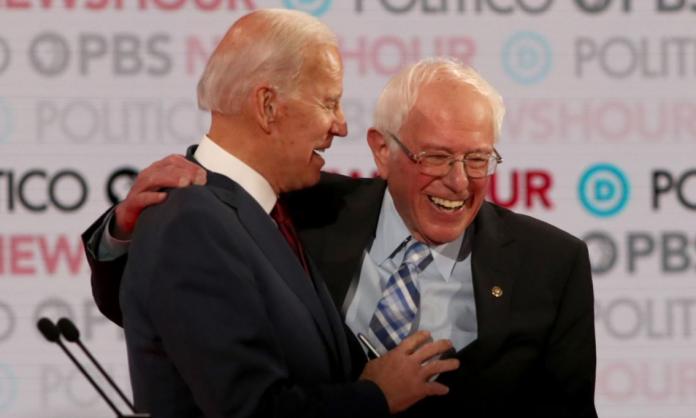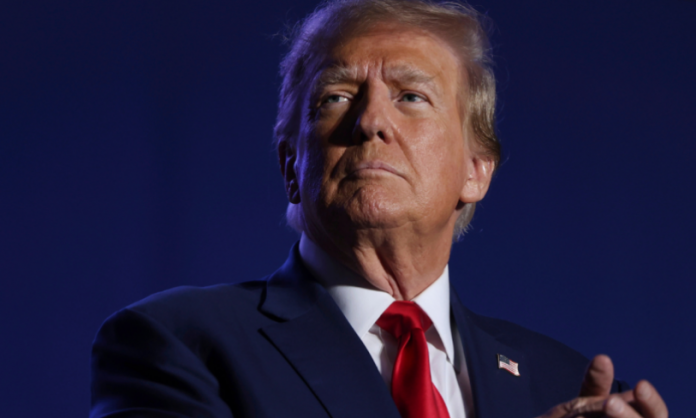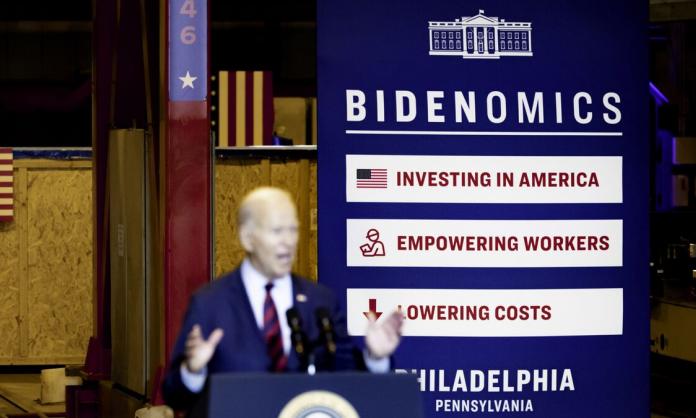Bernie Sanders inspired hope among millions of working-class Americans appalled by the dire state of US politics. With his attacks on the billionaire class, his talk of socialism and his program of Medicare for all, a $15 minimum wage and free university tuition at last, there seemed to be an alternative to far-right Republicans like Trump and despised pro-big business Democrats like Hillary Clinton.
Sanders tapped into a mood for change in an increasingly polarised US society. On the one hand, there was the growth in support for Trump and various far-right conspiracy theorists and outright fascist groups. On the other hand, there was a sustained increase in the number of people favouring some sort of socialist alternative to capitalism. As early as 2011, a Pew Research Center poll showed that most young people had a more positive view of socialism than of capitalism.
Sanders’ two presidential campaigns built on and reinforced these sentiments. His support was particularly strong among young people, a majority of whom now reject capitalism. This was an important development in a country where there is no equivalent to the Australian or British labour parties and where socialist ideas of all stripes had long been marginalised by the Cold War anti-communist consensus. A further reflection of this trend was the growth of the Democratic Socialists of America, which now claims something like 70,000 members.
You don’t have to scratch too deeply beneath the surface to understand why this shift occurred. The 2007-08 global financial crisis resulted in millions of US workers losing their jobs and/or their homes. But the banks and the giant financial corporations that caused the crisis were bailed out to the tune of trillions of dollars by Democratic President Barack Obama. Workers’ taxes paid for those handouts. The US, like most of the Western world, has become an incredibly unequal society. The minimum wage is derisory. Today’s young people are set to be worse off than their parents’ generation. Compounding all that are endemic racism and militarism: the unrelenting police shootings of Blacks and the long decades of murderous wars from Iraq to Afghanistan, justified by rampant Islamophobia.
The bind was that there were limits to Sanders’ politics, which constrained and eventually reversed the radical potential of his campaign. By the standards of most other Western capitalist societies, Sanders was a moderate social democrat. He was, for example, nowhere near as left wing as Jeremy Corbyn in Britain. Sanders could seem much more radical than he actually was because of the abysmally right-wing nature of US politics. While his program put forward important individual reforms, it was not an anti-capitalist program and Sanders never called for getting rid of capitalism.
Sanders is not an opponent of US imperialism. He is a strong advocate of a hardline US stance against China, is pro-Israel and has longstanding connections with sections of the military industrial complex. From early in his political career in Burlington, Vermont, Sanders was a strong backer of the police. So, unsurprisingly, he has refused to support the Black Lives Matter demand to defund the police.
These serious limitations of Sanders’ politics were glossed over or apologised for by most of his supporters on the left. Such an approach meant that newly radicalising young people were not educated in clear-cut anti-imperialist politics—vital for socialists in the US, which remains the number one imperialist power in an increasingly conflict-ridden world.
Furthermore, while Sanders called for building a movement, it was a movement aiming to get him and other progressive Democrats, such as Alexandria Ocasio-Cortez, elected to office, not a movement of workers and youth to fight in the workplaces and on the streets for major reforms or to challenge capitalism.
The bigger problem limiting the radical potential of the Sanders’ campaign was that it remained trapped within the framework of the Democratic Party—the number two party of US imperialism. Born as the party of the southern slaveholders, the Democrats have always served the interests of the rich and powerful and of US military might. From Wilson to Roosevelt to Truman to Kennedy to Johnson to Clinton to Obama, Democratic presidents have waged war after war of pillage and plunder.
Attempting to reform the Democrats is an utter dead-end for socialists. What is vitally needed in the US is a genuinely radical working-class political alternative to the Democrats. Sanders could have helped build such an alternative if, after his defeat in the 2016 primaries, he had run as a social democrat against both Clinton and Trump. But despite facing a brutal dirty tricks campaign by the Democrats’ corporate establishment, Sanders offered no alternative to his many supporters. He called on them to back the despicable Clinton.
Despite his supposed “independent” status, Sanders incorporated himself deeper and deeper into the Democratic mainstream after the 2016 elections. He tried to build, not a left-wing alternative to the Democrats, but a mildly progressive faction very much loyal to this party of big business.
To prove his loyalty in the 2018 midterm elections, Sanders campaigned for liberal, centrist and right-wing Democratic candidates. And from the outset of the presidential primaries, Sanders made it clear that he would back whoever won the Democratic nomination, even a hardline conservative like Joe Biden. Although he was again savagely done over by the Democratic establishment, Sanders remained true to his word. Indeed, Sanders and the likes of Ocasio-Cortez have gone out of their way to praise Biden.
In order to get on board left-wingers hostile to Biden, Sanders and other liberal Democrats have painted Biden as some sort of saviour of workers’ interests against Trump. This is despite Biden making it crystal clear that he will not back any of Sanders’ policies and focusing his campaign on making concessions to right-wing Republicans worried that Trump’s behaviour discredits US imperialism’s standing in the world.
So rather than working for a break from the Democrats, Sanders and the likes of Ocasio-Cortez have acted as a safety valve for US capitalism’s B team. They have tried to channel a growing radicalism, especially among young people, back into the discredited Democrats. Following this same trajectory, the Democratic Socialists of America have been increasingly incorporated as the progressive wing of the Democrats.
Sanders has joined a long line of past liberals, progressives and social democrats who have helped prop up the Democratic Party in the face of mass upsurges of disaffection by giving it a seemingly radical face. These various progressives have played and continue to play a vital role in maintaining the stability of US capitalism. Their role is one of the key factors in explaining why US workers don’t have their own party independent of the two mainstream capitalist parties, even a pathetically inadequate one like the British or Australian labour parties.
The other significant negative impact of the Sanders’ campaign has been on the politics of sections of the socialist left. Thrown off balance by the surge of support for Sanders, important sections of the socialist left threw themselves largely uncritically into his campaign. They embraced it as a get-rich-quick scheme for mass influence. Softening their socialist politics to fall in behind Sanders did nothing to advance working-class struggle or mass campaigns like Black Lives Matter or to build the revolutionary left. It strengthened the hand of the reformists and liberals who dominated and set the political terrain of Sanders’ campaign.
Numerous leftists abandoned the longstanding stance of the radical and revolutionary left in the US—from the syndicalists of the Industrial Workers of the World to Eugene Debs’ Socialist Party to the early US Communist Party to the Trotskyist movement—of not voting for candidates of either of the two dominant capitalist parties. Initially many on the left, including leaders of the Democratic Socialists of America, proclaimed that it was “Bernie or bust”—that they would campaign only for Sanders and not for a right-wing corporate Democrat like Biden.
But abandoning the socialist principle of not supporting candidates of openly capitalist parties in order to back Sanders and Ocasio-Cortez became a slippery slope. If you were prepared to vote for Sanders running as a Democrat on a mild social democratic program against Trump, it is no great further stretch to vote for the lesser evil Biden against the “fascist” Trump. Indeed, many of the former supporters of “Bernie or bust” have now caved in to the relentless campaign of the Democrats and the liberal establishment to back Biden.
But falling in behind Biden and the Democrats will do nothing to strengthen the hand of workers and the oppressed to resist the harsh attacks they will inevitably face, whoever sits in the White House after the presidential elections. Moreover, it will do nothing to counter the threat from the right, which has grown in the very soil of the harsh neoliberal capitalism championed Democrats such as Biden.
What is vitally needed in the US is a fighting socialist movement to champion mass struggles like the Black Lives Matter movement and to build broader working-class resistance. Those struggles won’t be advanced by tailing the Democrats, no matter how seemingly progressive, but only by building a militant working-class political alternative.











